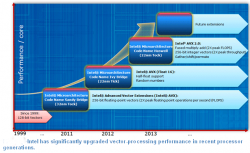Anand posted a review with a number of benchmarks today for Intel's new Haswell-E i7 enthusiast desktop CPUs. Based on what I can see, there's nothing notable in terms of performance improvements in real-world benchmarks although I'd be interested in hearing differing opinions...
The new 5930K should be indicative of a replacement for the nMP 6-core (1650v2) which is comparable to the IB 4930/60 used in their benchmarks.
As you will see, the Haswell 6-core 5930K offers nothing in terms of added performance over the Ivy-Bridge equivalents. Case in point... the new Haswells are right in-between the two Ivy variants...

So I wouldn't hold your breath for Apple to refresh the nMP based solely on Haswell... there's just nothing there but added expense. The only thing I can see driving a refresh of the nMP in the next year would be next-gen GPU tech.
The new 5930K should be indicative of a replacement for the nMP 6-core (1650v2) which is comparable to the IB 4930/60 used in their benchmarks.
As you will see, the Haswell 6-core 5930K offers nothing in terms of added performance over the Ivy-Bridge equivalents. Case in point... the new Haswells are right in-between the two Ivy variants...

So I wouldn't hold your breath for Apple to refresh the nMP based solely on Haswell... there's just nothing there but added expense. The only thing I can see driving a refresh of the nMP in the next year would be next-gen GPU tech.
Last edited:



